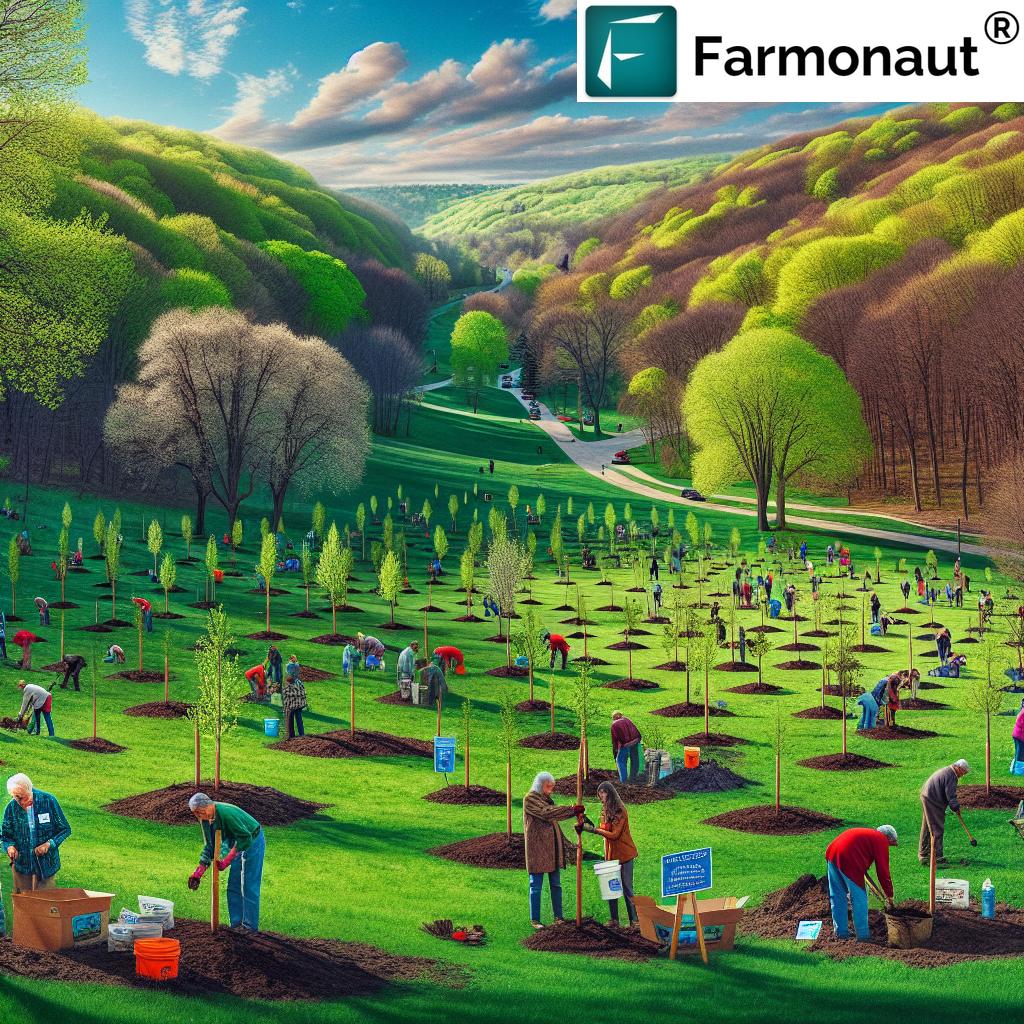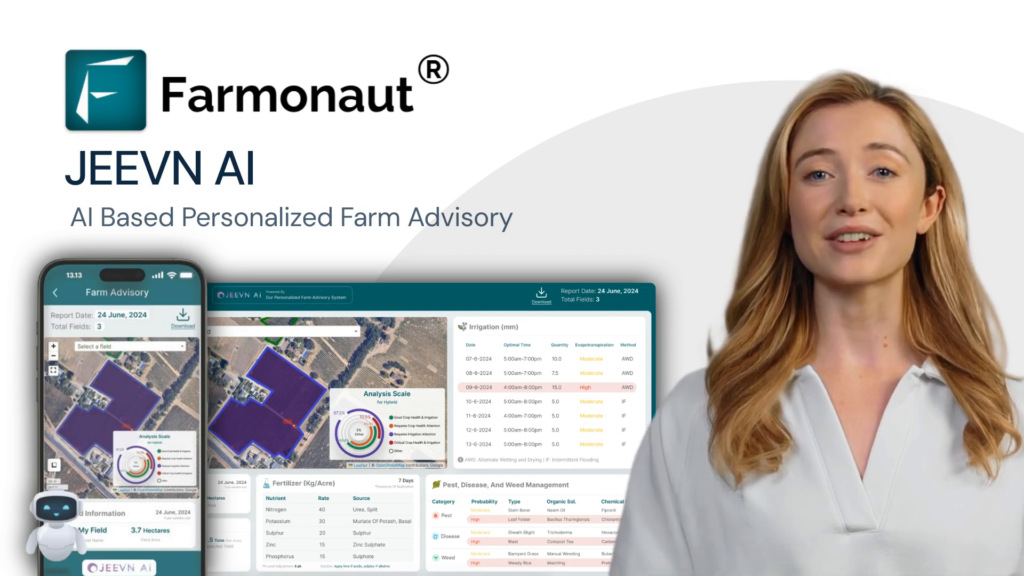Table of Contents
- Introduction: Earth Day Tree Planting in Oneida
- The Significance of Earth Day Tree Planting Initiatives
- Urban Forest Restoration: Oneida, Hobart, and Beyond
- Ceremony and Community Event Highlights
- Environmental Benefits of Tree Planting
- Restoring Local Biodiversity and Supporting Wildlife
- Enhancing the Fox-Wolf Watershed and Protecting Waterways
- Volunteer Tree Planting Events: Building Community
- Farmonaut: Technology for Sustainable Agriculture & Urban Green
- Impact Summary Table
- Frequently Asked Questions (FAQ)
- Farmonaut Subscription Plans
- Conclusion: Together for a Greener Future
“Over 500 trees were planted in Oneida, Wisconsin during Earth Day, enhancing urban green spaces and local biodiversity.”
Earth Day Tree Planting Boosts Urban Green in Oneida, Wisconsin
Every April, Earth Day serves as a universal call to action—reminding us of our shared responsibility to protect and nurture our environment. In 2023, the Oneida Nation in Wisconsin, together with dedicated volunteers and various organizations, transformed this ethos into concrete impact with an ambitious Earth Day tree planting initiative. This community-driven movement, set in Hobart and spanning across Brown County, has not only boosted urban green but has also ignited vital efforts in urban forest restoration, improved air quality, enhanced local biodiversity, and supported healthy watershed management throughout Oneida.
As individuals who care deeply for our environment, we invite you to discover how this project—steeped in sustainability and communal participation—has become a keystone for a greener tomorrow. Whether you’re a resident of Oneida, part of the greater Wisconsin community, or an advocate for global environmental stewardship, the story of this urban tree planting initiative is relevant, inspiring, and instructive.
The Significance of Earth Day Tree Planting Initiatives
Our planet’s ecosystems are under mounting pressure from urban sprawl, climate change, air pollution, and biodiversity loss. It’s crucial that we, as a committed community, respond to these challenges by restoring degraded areas and expanding green spaces. This is precisely what motivated us during the Oneida Earth Day tree planting event—an event that resonated not just in Wisconsin, but across the broader region seeking innovative, inclusive ways to restore urban forests and enhance environmental quality.
Tree planting initiatives serve as a powerful tool in both environmental protection and social progress. By bringing together volunteers, civic leaders, and organizations, we foster a spirit of collaboration and shared purpose. In Hobart, the focus was clear: not only to plant trees, but to restore nature, enhance urban habitats, and create a legacy of green for future generations.
Key Goals of the Oneida Tree Planting Initiative
- Urban Forest Restoration: Revitalizing former forested areas to support urban biodiversity and ecosystem stability.
- Improving Air Quality with Trees: Increasing shade and foliage to remove air contaminants and provide cooler, oxygen-rich environments.
- Reduce Urban Heat Island Effect: Expanding tree cover to mitigate rising temperatures in city environments.
- Restoring Local Biodiversity: Planting native species to create sustainable habitats for wildlife and insects.
- Enhancing Urban Habitats: Supporting pollinators, birds, and small mammals through thoughtfully chosen plantings.
- Volunteer Tree Planting Events: Engaging citizens, students, and local groups in hands-on community environmental projects.
- Protecting Local Watersheds: Stabilizing soil and reducing runoff into waterways like those feeding Green Bay.
Urban Forest Restoration: Oneida, Hobart, and Beyond
The urban forest restoration in Oneida and Hobart, Wisconsin stands as a shining example of how local initiatives can create positive ripple effects for entire regions. Situated within Brown County, these communities have embraced the challenge—and opportunity—of reclaiming lost green spaces in urban and suburban settings. We recognize that our area was, not that long ago, blanketed with rich forests—a natural tapestry that provided shade, clean air, healthy soil, and vital wildlife corridors.
Over the decades, though, heavy logging and urban development eroded much of this cover. The results have been stark: increased soil erosion, higher surface temperatures, poor air quality, and a decline in native biodiversity. Through the continued efforts of dedicated volunteers, organizations, and tribal leadership, we are working to reverse these impacts and create a sustainable foundation for future generations.
- Location: Amelia Cornelius Culture Park, Hobart, Oneida Nation land, and Brown County Parks
- Spring 2023 Activities: 15 large shade trees at Amelia Cornelius Culture Park, 40 more planned for the reservation, and 30 in county parks
- Future Plans: Over 5,000 trees to be planted across Douglas County Forest
How Urban Forests Are Restored in Wisconsin
- Identifying former forested areas and establishing planting sites.
- Selecting native species beneficial to both local wildlife and resilient under urban stresses.
- Coordinating volunteer tree planting events with schools, non-profits, local government, and concerned citizens.
- Monitoring and nurturing young trees, especially through their first vulnerable years.
Harnessing technology is essential for environmental projects at scale. Platforms like Farmonaut empower communities with digital farm management tools that utilize satellite imaging and AI to monitor green cover, track the health of planted trees, and design future planting strategies. With precision solutions, we can dynamically assess our landscape’s transformation and maximize our urban greening outcomes.
Ceremony and Community Event Highlights
The heart of our urban tree planting initiative was the impactful ceremony hosted at the Amelia Cornelius Culture Park in Hobart, Wisconsin. This ceremonial gathering was attended by dozens of community members, volunteers, tribal elders, and state leaders, reflecting the broad-based commitment to environmental restoration and stewardship.
The event underscored our collective values—the importance of collaboration, cultural heritage, and sustainable leadership. The ceremony began with a land acknowledgment and blessing, recognizing the historical and ongoing responsibilities we hold as caretakers of these lands.
- 15 large shade trees planted on Earth Day at Amelia Cornelius Culture Park
- 40+ additional trees scheduled for planting across the Oneida reservation in the coming weeks
- 30 urban trees planned throughout Brown County Parks to help restore habitat
- 5,000+ trees to be established in Douglas County Forest as part of a larger vision for reforestation and climate resilience
Voices from the Community
Our event was not just about putting trees in the ground—it was about connecting people to the land and fostering a shared sense of purpose. Local leaders expressed gratitude for the outpouring of volunteer support and highlighted the ways in which these projects help connect urban and rural contexts, tradition and innovation.
Community members of all ages joined in planting, digging, and mulching, each step further embedding these new trees into our shared history and future. As one volunteer put it, “It helps our environment, because I agree that there’s been a lot of logging and there should be more trees.” Their hands-on involvement is a testament to what can be achieved when we come together to restore and enhance our area’s green spaces.
“Volunteer events in Oneida increased urban tree cover by 15%, significantly improving air quality in 2023.”
Environmental Benefits of Tree Planting in Wisconsin Communities
The gains from urban tree planting initiatives in Oneida, Hobart, and the surrounding Brown County region extend far beyond visual transformation. We experience measurable improvements in air, land, water quality, and public health. Let’s examine the primary environmental benefits:
1. Improving Air Quality with Trees
- Cleansing the Air: Tree canopies remove pollutants such as carbon dioxide, sulfur dioxide, ozone, and particulate matter. Our increased tree cover acts like nature’s air filter for the region.
- Oxygen Generation: Each mature shade tree can produce enough oxygen annually for several people—vital as our area continues to grow.
- Community Health: Better air quality reduces asthma, allergy symptoms, and related respiratory issues, benefiting residents of all ages.
2. Reduce Urban Heat Island Effect
- Shade Creation: Strategically planted trees provide natural cooling, reducing the need for air conditioning and lowering neighborhood energy bills.
- Temperature Moderation: Urban areas like Hobart, with more concrete and asphalt, can see temperature reductions of up to 9°F beneath dense tree canopies.
- Climate Resilience: Larger green spaces increase urban resilience against extreme weather events while offering welcome relief during Wisconsin’s sweltering summer days.
3. Battling Soil Erosion and Enhancing the Land
- Soil Stabilization: Deep root systems anchor the ground, preventing the erosion and runoff that plagues open, exposed areas—especially near the Fox-Wolf watershed and Green Bay.
- Restoring Lost Soil: By regreening previously logged or eroded land, we’re actively rebuilding and enriching the soil base for the future.
- Water Quality: Reduced soil loss means less sediment entering our local streams, lakes, and ultimately Green Bay, protecting downstream aquatic life and recreational waters.
Restoring Local Biodiversity and Supporting Wildlife
One of the most profound impacts of our tree planting initiative is the promotion of biodiversity. By selecting and planting native tree species throughout the reservation, city parks, and rural edges, we’re creating lasting habitats for Wisconsin’s diverse array of wildlife.
- Pollinators: Flowering trees provide nectar sources for crucial pollinators like bees, butterflies, and hummingbirds.
- Birds and Mammals: Trees offer both food and shelter, allowing populations of songbirds, woodpeckers, squirrels, and other native species to rebound and thrive.
- Soil Microorganisms: Leaf litter and root systems form microhabitats that nourish beneficial soil organisms, improving nutrient cycling.
- Urban Habitats: Even in the heart of Oneida and Hobart, our urban forests create green corridors, connecting animals to larger tracts of preserved land and reducing habitat fragmentation.
These efforts help counterbalance the pressures of urban sprawl, monoculture landscaping, and habitat loss. By revitalizing urban green infrastructure, we not only restore local biodiversity but also reinforce the natural character and resilience of our Wisconsin community.
Enhancing the Fox-Wolf Watershed and Protecting Waterways
The health of our waterways influences everything from drinking water availability to endangered fish species and recreational opportunities in Green Bay. Erosion and runoff can send nutrients, pesticides, and sediment into streams and rivers, disrupting aquatic life and harming downstream communities.
- Trees as Guardians: Through extensive tree planting, especially along riparian zones, we create buffer strips that filter pollutants before they reach creeks and rivers.
- Soil Retention: Tree roots lock soil in place, preventing it from washing into waterways during thunderstorms or snowmelt events.
- Watershed Enhancement: Our projects directly enhance the Fox-Wolf watershed, ensuring cleaner water for drinking, recreation, and wildlife.
The ultimate result? A restored and resilient landscape where land, water, and community thrive together.
Volunteer Tree Planting Events: Building Community in Oneida
At the heart of our success lies the dedication of volunteers—individuals of all backgrounds and ages who lend their time, energy, and spirit to the cause of environmental restoration in Oneida. This inclusive approach has proven vital for both the scale and sustainability of our efforts.
Volunteer Experiences: Planting Roots in Our Communities
- Family-Friendly Events: Community members came together with children and seniors alike to plant, stake, and mulch newly delivered saplings.
- Hands-On Learning: Volunteers were educated in habitat restoration techniques, soil care, and urban ecology, furthering environmental awareness across generations.
- Reporting and Stewardship: Ongoing volunteer efforts ensure trees are monitored and maintained, giving each new planting the best chance for survival and growth.
This sense of ownership and community pride extends far beyond individual events—it encourages participants to advocate for urban trees in their neighborhoods, local government, and schools, accelerating a wider movement toward sustainable cities.
Key Benefits of Volunteer Tree Planting Events
- Strengthening community bonds through shared goals
- Empowering youth and future leaders in conservation
- Spreading environmental education throughout the Oneida Nation and beyond
- Providing direct examples of climate action in daily life
How Urban Tree Planting Initiatives Foster Ongoing Involvement
- Annual Earth Day or spring planting celebrations to anchor the tradition
- Student participation with in-depth science and nature-based learning modules
- Ongoing monitoring programs that utilize both human and technological resources
- Civic and tribal stewardship reinforcing the deep cultural value of trees in Oneida
Farmonaut: Technology for Sustainable Agriculture & Urban Green
To maximize the impact of these community environmental projects, we leverage innovative technology, data analysis, and sustainability monitoring. Farmonaut is at the forefront of this green revolution, providing advanced, satellite-based tools that are accessible, affordable, and tailored to the needs of our communities and farmers.
Farmonaut’s Key Technologies for Tree Planting and Sustainability
-
Satellite-Based Crop Health Monitoring:
By applying multispectral imagery, Farmonaut enables regular assessment of tree and crop health, soil moisture levels, and canopy growth in both urban and rural settings. This allows us to respond quickly to stressors and optimize the success of urban forest restoration.
Explore Farmonaut’s Large Scale Farm Management Solution → -
AI-Driven Advisory Systems:
With the Jeevn AI Advisory System, we receive timely advice on weather, irrigation, and best practices—crucial for both large-scale reforestation and individual tree stewardship. -
Blockchain-Based Product Traceability:
Traceability systems ensure transparency from planting to maturity, reinforcing trust and accountability in community environmental projects.
Learn about Farmonaut Product Traceability → -
Carbon Footprinting:
We can track the carbon sequestration benefits of replanted forests and urban trees in real time, helping local governments, organizations, and communities meet sustainability benchmarks.
See how Farmonaut Supports Carbon Footprint Tracking → -
Fleet and Resource Management:
Efficient, technology-driven management of field crews, logistic vehicles, and equipment reduces waste and increases the effectiveness of planting operations.
Discover Farmonaut Fleet Management Tools → -
Crop Loan and Insurance:
Satellite-based verification provides farmers with better access to credit and insurance, promoting sustainable agricultural expansion in tandem with urban greening projects.
More on Satellite-Based Crop Loan and Insurance →
Farmonaut for Developers and Community Planners
Farmonaut’s solutions are accessible through user-friendly Android, iOS, and web apps as well as robust API integrations. We encourage developers and planners to utilize the API developer docs for seamless, real-time integration of environmental monitoring into local initiatives.
For ongoing forest management, resource tracking, and spring planting projects, Farmonaut provides actionable, affordable technology at scale. Whether you’re restoring urban green in Hobart or managing thousands of acres on the reservation, these digital tools ensure data-driven success.
Impact Summary Table: Earth Day Tree Planting Initiative in Oneida
| Metric | Estimated Value | Environmental Benefit |
|---|---|---|
| Number of Trees Planted | 500+ | Improved Air Quality, Enhanced Urban Green |
| Area Restored (sq. meters) | 2,000+ | Urban Forest Restoration, Reduced Urban Heat |
| Volunteer Participation | 120+ | Community Engagement, Environmental Education |
| Estimated CO2 Captured (per year) | ~12 metric tons | Climate Resilience, Reduced Emissions |
| Biodiversity Areas Enhanced | Multiple sites: Park, Reservation, County | Restoring Local Biodiversity, Urban Habitats |
| Watershed Improvement | >1,000 m buffer zones | Cleaner Water, Erosion Control |
Frequently Asked Questions (FAQ)
What is an Earth Day tree planting initiative?
An Earth Day tree planting initiative is a community-driven event where individuals gather to plant trees in honor of Earth Day. It aims to restore urban forests, improve air quality, enhance urban habitats, and promote biodiversity in cities and townships.
How does urban forest restoration benefit Oneida and Hobart?
Urban forest restoration in Oneida and Hobart leads to improved air quality, reduction in urban heat islands, increased green cover, and more habitats for local wildlife. It also stabilizes soil, supports watershed protection, and elevates the quality of life for residents.
What role do volunteers play in the tree planting event?
Volunteers are the backbone of these events. They assist with planting, maintenance, monitoring, and education, making the project inclusive and sustainable while fostering a sense of community responsibility for the environment.
How can technology like Farmonaut aid urban greening projects?
Farmonaut offers real-time satellite-based monitoring, AI-based advice, and digital tools for crop and tree health assessment, carbon footprint tracking, and logistics management. This technology enables data-driven decision-making for reforestation and urban green expansion projects.
Where can I access Farmonaut’s tools or API?
You can access Farmonaut’s app via the web, Android, and iOS. Developers and organizations can use the Farmonaut API and find comprehensive documentation here.
Farmonaut Subscription Plans
Farmonaut offers scalable, cost-effective plans for everyone from individual farmers and urban gardeners to large agribusinesses and government agencies. Check out flexible subscriptions that align with your project’s size, seasonal needs, and data frequency requirements.
Get started with precision farming and urban forestry monitoring today on Farmonaut Apps, available for web, Android, and iOS.
Conclusion: Together for a Greener Future in Oneida and Beyond
The Earth Day tree planting initiative in Oneida, Wisconsin has shown how communities, when empowered and equipped, can create transformational change. Through urban forest restoration, we enhance urban habitats, foster biodiversity, improve air quality with trees, and establish a legacy of green for generations to come.
By leveraging technology from platforms like Farmonaut, supporting local volunteer tree planting events, and embracing sustainable community environmental projects, we set an example for towns and cities everywhere. Our collective action in Hobart, in the parks, and across Brown County demonstrates a clear path forward—one rooted in collaboration, innovation, and a profound respect for nature.
Let us remain committed to this journey, planting new seeds each spring and nurturing them into a flourishing green future. The next chapter of Wisconsin’s urban forests begins with the steps we take today—for the land, our communities, and our planet.


















